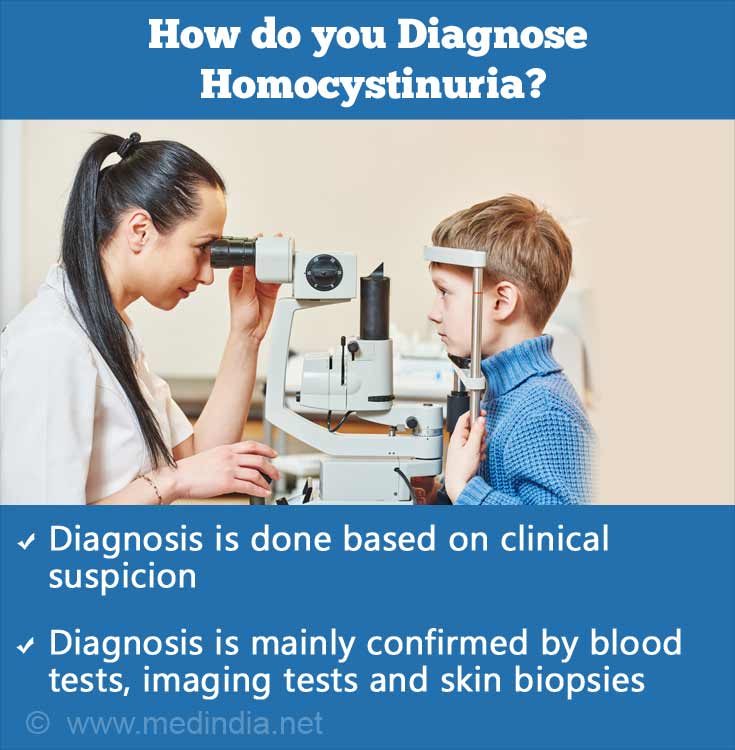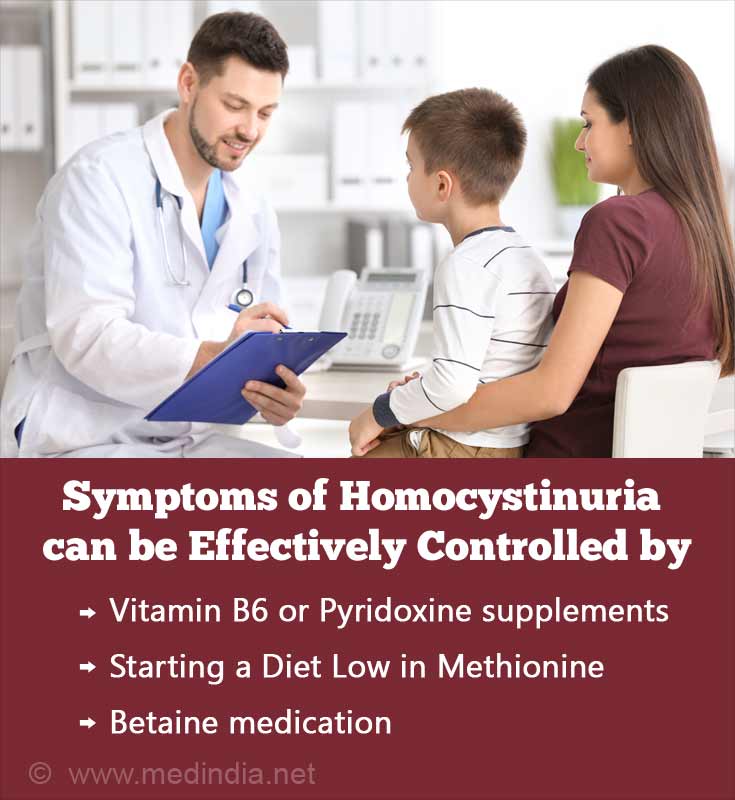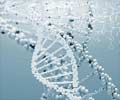- Homocystinuria - (https://ghr.nlm.nih.gov/condition/homocystinuria)
- About Homocystinuria - (https://www.nhs.uk/conditions/homocystinuria/)
What is Homocystinuria?
Homocystinuria is a rare inherited genetic disorder. It is characterized by increased levels of the amino acid homocysteine in blood and urine. Along with elevated homocysteine levels, the levels of methionine (another essential amino acid in humans) are also increased as the body is unable to process the methionine. Affected children seem to be normal at birth but may suffer severe complications during childhood. Therefore, early diagnosis and treatment is important to avoid or reduce the severity of these complications.
What are the Types and Causes of Homocystinuria?
- When the term homocystinuria is used, it normally refers to classical homocystinuria caused by deficiency of the enzyme cystathionine beta synthase (CBS). This is the most common type of homocystinuria and its occurrence is rare with a frequency of 1 in 200,000 to 335,000 people globally. The defect has been mapped to a gene on chromosome 21. It is an autosomal recessive condition meaning that both inherited copies of the gene are abnormal. This means that both parents of the affected child are carriers of one defective copy of the gene and hence do not show the features of the disease
- In addition to CBS deficiency, there are six other distinct types of homocystinuria due to other enzyme deficiencies including
- 5,10-methylenetetrahydrofolate reductase deficiency
- Deficiency of cobalamin in coenzyme synthesis – (including five subtypes)
These other deficiencies are severe and reported even more rarely; information is therefore limited and the following discussion will be about classical homocystinuria caused by cystathionine beta synthase (CBS) deficiency.
How Does CBS Deficiency and Increased Homocysteine Levels Affect the Body?
Homocysteine is normally formed in the body from the sulphur-rich amino acid methionine. Thus methionine is the preceding substance or precursor for homocysteine.
The enzyme cystathionine beta synthase (CBS) is necessary for conversion of homocysteine to cysteine. When CBS is deficient, homocysteine accumulates in the tissues along with its precursor aminoacid methionine.
High levels of homocysteine mainly affect supporting connective tissue in different parts of the body, for example by making the protein fibrillin unstable which is necessary to hold the lens of the eye in its normal position. The build-up of homocysteine also damages the supporting tissue of the body’s skeleton, and damages the connective tissue in the walls of blood vessels. In the brain, nerve cells are affected.
What are the Symptoms and Signs of Homocystinuria?
The clinical features mainly reflect the weak supporting connective tissues in these persons. Symptoms usually become evident by 3-4 years of age. The important findings in classic homocystinuria due to CBS deficiency include
- Dislocation of the eye lens
- Myopia or nearsightedness – ability to see objects closer to eye while distant objects appear blurred
- Increased intraocular pressure or glaucoma
- Tendency to form blood clots - Most common cause of complications and premature death. Women having the condition should avoid taking contraceptive pills containing estrogen which further increase the risk of clots. Precautions should be taken before surgical procedures to avoid clot formation
- Osteoporosis, or weakening of the bones
- Chest abnormalities, such as bulging out or a caved-in appearance of the sternum or breastbone
- Long and thin limbs causing tall stature
- Abnormal shape of the spine causing the spine to be curved (scoliosis)
- Learning problems
- Delayed milestones
The clinical features of the rarer forms also have in addition the following features
- Megaloblastic anemia, a type of anemia having larger-than-normal sized red blood cells
- Seizures
- Impaired brain function
- Difficulties in walking and movement

How do you Diagnose Homocystinuria?
Diagnosis is suspected during clinical examination and based on clinical suspicion diagnosis is confirmed by blood tests, imaging tests and skin biopsy.
Physical examination
The diagnosis is suspected in persons/children with long, thin build, lens dislocation, glaucoma and developmental abnormalities.
Blood and Urine tests
Increased levels of the aminoacids homocysteine and methionine in blood and urine.
Skin biopsy
To confirm the diagnosis, CBS enzyme activity can be measured and will be low in a type of cell called fibroblast found in the connective tissue layer of the skin by obtaining a sample of skin, or from white blood cells (lymphocytes). These may not be needed in typical clinical presentation along with elevated aminoacid levels.
Imaging Tests
X-rays of long bones and pelvis and dual-energy X-ray absorptiometry (DEXA) scan may demonstrate changes of premature osteoporosis (weak and porous bones)
Genetic testing
Genetic testing can be done to look for presence of the abnormal gene

How do you Treat Homocystinuria?
There is no cure for homocystinuria. With early diagnosis, the symptoms can be effectively controlled by the following measures:
Vitamin B6 or Pyridoxine
The treatment of choice is pyridoxine to reduce homocysteine levels. In patients who respond to pyridoxine termed “pyridoxine sensitive”, it is given in combination with folic acid and vitamin B12
Diet Low in Methionine
Children who do not respond to pyridoxine (pyridoxine insensitive) are started early on a diet low in methionine in consultation with a dietitian. High protein foods such as meat, eggs, pulses, cheese, nuts and fish have to be restricted. The modified diet has to be followed lifelong
Breastfeeding and formula milk in infants has to be regulated and special formula milk and diet supplemented with essential minerals, vitamins and aminoacids should be given
Medication
Along with pyridoxine and dietary restriction, a medicine called
Miscellaneous Measures
- Folate deficiency should be avoided with diet supplements
- Occurrence of heart disease can be prevented by prophylactic aspirin
- Evaluation of eyesight by an eye specialist and correction of dislocation as appropriate
- Evaluation of spine abnormalities by an orthopedic surgeon and correction if required and followup by a physiotherapist
- Treatment of seizures
- Correction of Inguinal Hernia Surgery
- Management of learning disabilities with specialized teams comprising teachers, special educators
- Adults with homocystinuria with reduced movement and intellectual development may need special nursing homes designed to help with activities of daily living
Periodic Evaluation of the following
- Levels of homocysteine and methionine should be monitored periodically
- Mineralization of the skeleton should be estimated regularly
- Periodic eye pressure measurements
- Investigations to identify blood vessel abnormalities
- Mental evaluation

How to Prevent Homocystinuria?
- It is difficult to prevent homocystinuria as this disorder occurs due to genetic mutations. You should think of going to a genetic counselor if there is a family history of homocystinuria. Prospective parents can employ this method to estimate the risks of having a child who might have the disease
- Asking for an intrauterine diagnosis of the disorder during pregnancy is another method to possibly prevent this condition. A sample of amniotic fluid is obtained and tested for the presence of the genetic mutation
- Complications of homocystinuria may be prevented by screening of newborns with a blood test around five days within birth to check for the condition so that early treatment can be started







